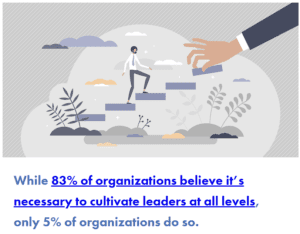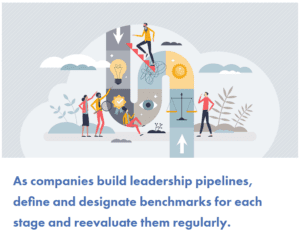Strategies for spotting and cultivating the next generation of leaders.
By Alice Carleton
C-suites are making room at the table for another seat: “Head of People Potential.” It’s a role missing from many HR departments, but as HR evolves, it’s time for the head of people potential to shine. Why? Because great leaders are made—they don’t develop by accident.
Leadership development throughout all levels of an organization is critical for future success. After all, it isn’t just executives and those in the C-suite who are leaders. Ironically, while 83% of organizations believe it’s necessary to cultivate leaders at all levels, only 5% of organizations do so. That’s a problem.
Leaders are the innovators, rainmakers, and outside-the-box thinkers not afraid to ask, “What if?” If companies don’t provide enough opportunities for followers to evolve into leaders, they stagnate. A dearth of leaders or reluctance to prioritize leadership development can result in higher staff turnover, poor employee performance and morale, and less collaboration.
The benefits to leadership—and the impact of championing leadership development—cultivates a workforce of empathetic employees with high emotional intelligence, resilience, grit, and determination, even when there are challenges. Focusing on employee leadership development increases retention and long-lasting gains and provides motivation, purpose, and direction.
Too many companies face a conundrum: They see the value of developing leaders but struggle to find the right processes and support to ensure their employees thrive and grow into leaders.
Measuring Employee Potential
Good leaders not only appreciate their employees but find ways to support and evaluate them and help them grow into leadership roles. HR can help leaders understand how to evaluate their colleagues’ potential and recognize and nurture talent by considering key factors:
- Ability: how well an employee performs in their role.
- Adaptability: how an employee responds to evolving or rapidly changing situations.
- Aspiration: an employee’s drive to succeed in their role.
- Behavior and leadership qualities: an employee’s personal characteristics required for them to achieve success in their current and future roles.
- Relationships: an employee’s interpersonal skills and how they relate to others.
Management teams can help identify employees who stand out from the crowd. Why? Because potential leaders share many of the same characteristics. They’re good at their jobs, and their colleagues trust and respect them. They welcome feedback on their performance and make adjustments. They’re motivated to develop new skills and hone existing ones. They often take on additional responsibilities outside their role’s scope, especially when they’re interested in the company’s future success. Both collaborative and supportive of others, they take the initiative and work autonomously. They’re also forward-thinking and interested in pursuing leadership and growth opportunities.
Strategies for Developing Employee Leadership Skills
When identifying potential leaders, HR should evaluate an employee’s courage, curiosity, ingenuity, self-awareness, service orientation, and vulnerability. That’s the first step. And many effective management techniques exist to guide their development into leaders.
Options include talking with rising leaders to help them define their goals and give them visibility, connecting them with a mentor, and providing the tools to identify their strengths and weaknesses. Companies should encourage senior staff to work directly with developing leaders, allow them to fail and turn those failures into learning opportunities. Finally, employees should have a clear road map for growth.
Find a Sustainable Approach
The process doesn’t have to be complex or complicated. A sustainable rather than a one-and-done approach helps employees reach their full potential. Don’t make the mistake of taking shortcuts—they don’t work. As companies build leadership pipelines, define and designate benchmarks for each stage and reevaluate them regularly. A well-defined plan of action clarifies growth potential organization wide. Combining clear, comprehensible messaging and straightforward direction facilitates leaders’ abilities to evaluate results.
Infuse Company Culture with Leadership Development
For this approach to work, HR will need buy-in from the rest of the executive team to embed leadership development into the company culture. When organizations value and champion professional development, employees feel encouraged to expand their skillsets. But merely offering a selection of training programs doesn’t go far enough.
Ensure those lessons stick by integrating formal training opportunities on a consistent rotation—and supplement them with continued engagement, ongoing conversation, and other support. To encourage employees to prioritize their training, HR must evangelize leadership development as essential—not a luxury, committing the time and resources to make it happen.
Elevate Leadership Training with Interactivity
Leadership training should include interactive content. Incorporating it encourages continuous engagement—a necessity for nurturing newer and developing leaders. Interactive content creation platforms elevate learning well beyond reading static content, taking quizzes, or completing modules online.
Another benefit to interactive learning? Higher completion rates and a deeper understanding of the content. Plus, enhanced learning experiences incorporate fun into the process with gamification and other strategies. That experience helps cultivate more creativity—a valuable trait for leaders and one CEOs credit as the primary contributor to their success.
Creativity is an essential leadership characteristic because it generates more innovative thinking and problem-solving—and can also motivate employees and reduce workplace stress.
Companies benefit from good leadership. Strong leaders translate an organization’s values into actions to fulfill those values. Empowered leaders continue developing themselves and others. Those leaders don’t produce more followers but help create more leaders.
Growing companies rely on a steady pipeline of new leaders. They find, own, and lead newer opportunities. They fill gaps when others get promoted or move into different positions. And they bring fresh perspectives to a company’s strategy. When organizations don’t prioritize leadership development, they risk losing 7% of total annual sales for every year it’s delayed. Is the cost worth it?
Alice Carleton is vice president of people potential at Ceros.
















